Wigtown was made a royal burgh in 1469 although a settlement here existed long before this. The burgh is mentioned in an indenture of 1292, and the fact that the sheriffdom was in existence at the time of the Largs campaign of 1263 suggests that the burgh may also have been recognised as such during the reign of Alexander III.
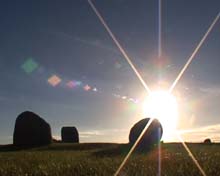
Torhousekie Stone Circle
The royal burgh was granted to Sir Malcom Fleming by David II in 1341. Wigtown later passed to the Earls of Douglas and was restored to its former tenure as a royal burgh as a result of the forfeiture of the Douglases in 1455. Its status was formally recognised be a royal charter in 1457 and from then the burgh was firmly fixed by a feud-charter at the old figure of £20 per annum. Wigtown attended Parliament regularly from 1469 and the Convention of Royal Burghs from 1575.
Name origin[]
W.F.H. Nicolaisen offered two explanations for the place-name Wigtown. One theory was that is meant ‘dwelling place’, from the Old English wic-ton; however, if it is the same as Wigton, Cumbria, which was Wiggeton in 1162 and Wigeton in 1262, it may be ‘Wigca’s farm’. Other sources have suggested a Norse root with 'Wic' or 'Wig' meaning 'bay' giving the origin as a translation of 'The town on the bay'.
Trading origins[]
Wigtown in part owed its origins to the sea and its prosperity to trade. The burgh appeared briefly in the customs report for 1330 and 1331, but the amount collected was small and her hey-day as a port was principally in the fifteenth century. At the best of times, trade in the south west of Scotland was small in quantity. In 1500-1, for example, only two ships called at Wigtown and Kirkcudbright, and at other times there was no overseas trade at all. Even as late as the reign of James V the bulk of the trade from Scottish ports was centred on Edinburgh, Dundee, Aberdeen and Pittenweem and the five principal west coast ports between them – Ayr , Irvine, Dumbarton, Wigtown and Kirkcudbright – yielded less than five per cent of the crown revenue from the customs. In the 14th century west coast trade was an even smaller proportion.

Wigtown and the Galloway Hills, seen from Kirkinner
Among the five west coast trading ports, Kirkcudbright and Wigtown were the great rivals. In 1471 Wigtown exported £17 10s 0d worth of goods and Kirkcudbright £23 15s 0d. A few years later in Wigtown exported 1,250 hides as opposed to 1,000 for Kirkcudbright. Naturally, the emergence of Wigtown hurt Kirkcudbright as a trading port; however, as Kirkcudbright declined so in time did Wigtown. Part of Wigtown’s decline may be attributed to the fact that she did not get involved in the herring trade, which was the major export for a number of west coast ports such as Ayr and Irvine in the fifteenth century. Moreover, Wigtown was a conservative merchant community, and its exclusive trading privileges granted to them by James II increasingly became threatened by Whithorn.
Decline[]
From Wigtown’s position on the sent rolls a steady decline is shown in her economic position during the seventeenth century. In 1597, four principal ports of Dumfriesshire and Galloway were taxed by the Convention of Royal Burghs. In that year, Wigtown was set at fifteen shillings, Dumfries paid thirty-six shillings and eight pence, Whithorn, five shillings and Kirkcudbright, eighteen shillings. In 1649, Dumfries had shown a marked increase, but the rest had all declined. Wigtown paid a set rate of fourteen shillings in 1649, and the figure remained the same in 1670, but slumped dramatically to six shillings in 1692. The report to the Convention of Royal Burghs in that same year pessimistically reported that there was no foreign trade and that the town owned no ships or boats. Existing inland trade was ‘very considerable’ and came in from Ayr, Glasgow and Dumfries. Although the town is stated not to have had a weekly market, it did have our yearly fairs.
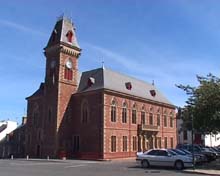
Wigtown's former seat of government, the County Buildings
Throughout the eighteenth century Wigtown remained primarily an agricultural town, serving an intensely rural area. Like other towns in Galloway, Wigtown did not grow to any appreciable size. The population of the parish was 1032 in 1755, while in 1739, it stood at 1350. The reporter in the Statistical Account noted that the population was declining in the rural parish and increasing in the town for two reasons: one, because of the enlargement of the farms which forced farms servants to seek employment of the in the town, and secondly, because of the Irish immigrants.
Residents of Wigtown and the surrounding area earned their bread and butter in a variety of ways. One eighteenth-century observer commented that from its ‘peculiar position in relation to the sea’, the county of Wigtown offered ‘many singular advantages to the landing of smuggled goods and smugglers were not slow in taking advantage of smuggled goods and smugglers were not slow in taking advantage of this’. Wigtown town council in July 1774 recognised the ‘pernicious and fatal consequences’ of smuggling all types of prohibited goods, particularly tea, from the Isle of Man. The council further denounced the drinking of tea and brandy as their purchase drained specie from the county which could be more naturally employed in the manufacture of their own wool. Despite this plea, it was only at the end of the century that the town appears to have adopted industry. The reporter in the Statistical Account noted that in Wigtown, as in almost all the other towns in Galloway, there was a want of industry; however, ‘something of a manufacturing spirit has arisen in this part of the county’. Two small wool and cotton manufactures were introduced into the town in the early 1790s, and although the woollen industry was much healthier than the cotton, both exported goods to England.
Geography and appearance[]
Andrew Symson, a seventeenth century minister of the church at Kirkinner (four miles south of Wigtown) left us a very early description of Wigtown. Writing in 1684 he noted that ‘the parish hath in it a burgh-royal also called Wigtown, which town, as the inhabitants say, of old stood more than a mile eastward, but that place is now covered at every tide’. Thus the first settlement would have stood on low-lying sands between the present-day Wigtown and Creetown, although no remains have ever been found to prove this assertion. Symson continued by describing Wigtown as an indifferently, but well-built town with a large, broad street.
This large, broad street was the focal point of settlement in the medieval town, but it was greatly altered at the beginning of the main street which in turn terminated in the latter-day Bank Street. High Vennel and low vennel are both early thoroughfares, but Agnew Crescent and Harbour Road were formed subsequent to 1750.

The Square looking West from the County Buildings
Town Council improvements in the early nineteenth century greatly altered the face of Main Street. In 1809 town magistrates resolved to improve the main street at a moderate expense by lifting the pavement and making a gravel road around each side of the street, the outer edge of which was to be forty-four feet from the edge of the houses. A ‘plantation’ was to be left in the centre of the thoroughfare, which was later laid out with shrubs and enclosed by a rail. In 1830, the Wigtown Bowling club obtained a footing in the ‘plantation’ and by the turn of the twentieth century, the square was used largely by bowlers and tennis players. Much of the square was planted up in the mid-twentieth century but in 2002 it was restored to the elegant Georgian open plan fringed by trees.
Market[]
By the late seventeenth and early eighteenth centuries, Wigtown Market does not appear to have been regularly attended. The town council in 1683 was forced to take steps in an effort to encourage attendance at the weekly market and to discourage forestallers and regraters, i.e., those who would sell goods before the official market time, or ones who would later re-sell items at a profit. The legislation seems to have had little effect, for in the following year, Andrew Symson noted that the town was of ‘small trading…. Their market day is Monday; but it is not frequent’. The 1692 report to the Convention of Royal Burghs also made the observation that the town had no weekly Market, but did maintain four yearly fairs. Market facilities also appear to have been poor, for it appears that ‘Wigtown seems not to have had a properly covered market place so that the church was used for that purpose’. In recent years Wigtown has held a market in the square on Saturdays during the summer.
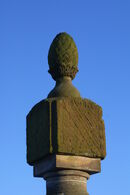
The original Mercat Cross.
The earliest reference to the market cross and tron of Wigtown occurs in the 1457 charter. It appears that the market cross stood in front of the old court house and was removed for a short time in the eighteenth century. While the square was under construction, the market cross was stored in the jail, A second market cross was erected in the main street in 1816, and at some point the original was brought out of its confinement and placed to the west of it. At some time later the older market cross was repaired, re-painted, and re-sited to the east of the second.
"Ports"[]
Wigtown had two ports which some writers have asserted were closed at night to form a large cattle enclosure. Andrew Symson referred to the East Port, which stood near NX 4352 5545 (Ordnance Survey Record Cards, NX 45 NW 18), The West Port stood opposite the mouth of the High Vennel and traces of it were still to be seen in the 1930s. The ports of the town were formed by projecting houses stretching across the street from both sides and a gate being placed in the centre. In the late nineteenth century, one of these projecting houses still stood at the site of the West Port, and was a thing, in his opinion, ‘anything but ornamental to the town’. The town council in 1761 decided that the ports were ‘hurtful to the place’ in that they ‘greatly incommode the carrying of corps of the deceased through the same’. Stone from the ports, which were ordered to be pulled down to there their foundations, was ordered to be stored in a most secure manner, so that ‘they may answer the uses of the burgh when they have the occasion’. In 1742 there is a reference to digging a well outside the west Port. This well would probably have been the one known as the White Pump. Another two wells were supposed to have been at the castle and friary respectively.

The 1816 Mercat Cross.
Castle[]
The castle of Wigtown was in existence by 1291. It was located on flat land down by the river Bladnoch, while the town and church were on a hill, ‘an inversion of the usual arrangements’. Nothing remains of the structure although a strong natural site and indication of a large enclosed and defended area seems to point to a castle of the Edwardian type, dating from the ending of the thirteenth century. The site of the castle was excavated after a fashion about 1830, by a Captain Robert M’Kerlie and a team of volunteers. The outlines of a building were clearly traced on this occasion and a ditch, which had been broad, was distinctly seen on the north where there was also a semi-circular ridge of considerable elevation said to be the remains of the castles outer wall. Within a matter of years following the ‘excavation’, the reporter in the New Statistical Account wrote that a fosse was quite discernible, although ‘the foundations of the walls cannot now be traced'. Mortar and ‘other remains indicative of an ancient building’ were still to be observed.
The castle's history is virtually unknown. Bruce may have issued orders for its demolition. The only known hint of its existence after the period of the Wars of Independent occurs in a charter of 1451 when a turris (tower) of Wigtown is mentioned. Its convenience as a local quarry undoubtedly accounts for its total disappearance.
Religious buildings[]
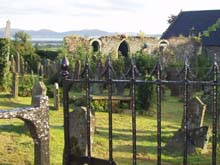
The ruins of St Machute's church, Wigtown
The parish church of Wigtown was dedicated to an obscure Welsh saint, Machatus. Precisely how old the church is remains a mystery, and although at one time it belonged to the priory of Whithorn, Wigtown parish church was afterwards set up as a free rectory with the king as patron. A church was erected on the site of the medieval parish church in 1730 and almost within a century that church was ruinous for a third parish church was built close by in 1850. Portions of the 1730 church survive, although fragments of this may in-fact be older than that date, for there is a window, on the south side aisle ornamented with trefoiled heads and stone mullions with shields carved on them. Some residents of Wigtown maintain that the ruins date back to the thirteenth century. A Roman Catholic Church was built in the town in 1879.
A Dominican Friary was founded in the town by Devorgilla (who also founded Sweetheart Abbey)in 1267. The site of the friary has not been clearly established although Symson observed that 'on the southeast of this town, there was long since a friary but the ruins there of are almost ruined'. The friary is in fact first mentioned in authentic historical revenues of this house were probably made over to the town at the Reformation, but no record has been found on any such transaction. The friars had been granted the fishings on the south side of the Bladnoch and in 1526 James V gave them those on the north side as well in a thirteen year lease which was subsequently turned into a gift. On this fishing stood the town’s mill.
Other buildings[]
An early reference to a tollbooth in Wigtown occurs in 1591, and it is possible that this structure was blown up by gunpowder in the eighteenth century to make way for the Market (or Court) house mentioned by Bishop Pococke in 1760 and another eighteenth century writer, Samuel Robinson. This municipal building is its turn gave way to the current County Buildings which were erected in 1862, a with its unusual French-style architecture. The county buildings were restored in 2002/2003 following decades of neglect.
Wigtown’s grammar school is the oldest in the county, although it is early history is unclear. Up until 1712 the school does not appear to have been conducted in a building set aside for that purpose, and it was in that the council ordered all inhabitants owning horses to bring a draught of timber from a nearby wood to help in the construction of a schoolhouse. Near the end of the century the council noted that the schoolhouse was overcrowded and needed improvement, but because of the poor state of the town’s finances, the magistrates could do little to help at that time. The schoolmaster was urged to find more room in the town at the expense of the ‘stranger scholaris’. A Roman Catholic primary school was built opposite the school but closed in 2004.
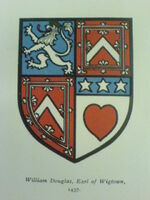
The Armorial Bearings of William Douglas, Earl of Wigtown.
One eighteenth-century historian of the county Samuel Robinson noted that ‘the greatest number of houses were of a homely character, thatched and one storey high’. Each house, he continued, had a midden in front of it. Bishop Pococke in 1760 also noted the existence of thatched houses. By the end of the nineteenth century it was said that two houses in the town were hardly the same; some had gable ends, others had large fronts pierced by pigeon-hole windows, while still others had outside stairs.
Gruesome aspects of history[]
During "The Killing Times" of the Covenanters in the Seventeenth Century Margaret McLachlan, an elderly woman in her 60's, and Margaret Wilson, a teenager, were sentenced to be tied to stakes on the merse at Wigtown Bay to be drowned by the incoming tide. Margaret McLachlan, was staked further out. The ploy being that the younger Margaret might be persuaded to change her mind. All attempts to persuade her to change her mind failed and despite a tall dragoon being ordered to hold her head up she too was drowned. This barbaric execution was carried out by dragoons under the command of Major Windram in the presence of Sir Robert Grierson of Lag who held the King's Commission to suppress the rebels in the South West. Their story, as told in various sources, tells how the women were betrayed by an informer. After about a month in prison they were tried as rebels and sentenced to death by drowning. Monuments to the 'Wigtown Martyrs' exist in Wigtown and a more elaborate Victorian memorial can be found in Stirling. Andrew McCulloch, author of Galloway, A Land Apart, suggests that although the women were sentenced to death by drowning there is no evidence of the sentence being carried out.
Another macabre story from Wigtown is set among the ruins of Baldoon Castle, a mile from the town. The ruins themselves, quiet and deserted and with an air of tragedy about them, are haunted by the ghost of Janet Dalrymple who walks here in the small hours, her white garments splashed with blood. In the middle of the seventeenth century Janet, the eldest daughter of Sir James Dalrymple, was forced by her parents to marry David Dunbar, heir of Sir David Dunbar of Baldoon, although she loved the practically penniless Archibald, third Lord Rutherford. Dutifully, and worn down by her parents' persistent objections to Archibald, Janet at last married David Dunbar in the kirk of Old Luce, two miles from Carsecleugh Castle, the old home of the Dalrymples. Her two brothers took her to the church and both declared later that her hands were cold as ice on that hot summer day.
There are three main versions of the events that gave rise to the haunting. In the first version the bride stabs her bridegroom in the bridal chamber and dies insane; in the second version the bridegroom stabs the bride and is found insane; and in the third version the disappointed Archibald conceals himself in the bridal chamber and escapes through the window into the garden after stabbing the bridegroom. Whatever the facts, Sir Walter Scott immortalised the story in The Bride of Lammermoor and describes how the door of the bridal chamber was broken down after hideous shrieks were heard from within and how the bridegroom was found lying across the threshold, dreadfully wounded and streaming with blood, while the bride crouched in a chimney corner, her white night-gown splashed with blood, grinning and muttering and quite insane. She never recovered and died shortly afterwards, on September 12th, 1669.
Dunbar is said to have recovered from his wounds but refused to discuss the events of his bridal night. In due course he married a daughter of the seventh Earl of Eglinton and eventually died from a fall from his horse in 1682. Archibald, Janet's true lover, never married and died in 1685. A macabre touch is added to the story by local tradition that it was the Devil who nearly killed Dunbar and who tormented poor Janet until she was demented. Whatever the events of the night, they seem to have left their mark here forever and there are some who claim to have seen the sad and awesome ghost of Janet wandering pathetically among the quiet ruins, most often on the anniversary of her death.
Railway[]
The Newton Stewart to Whithorn Branch Line Railway stopped at Wigtown Station (the first train ran on 2nd March 1875). The service ceased in 1950. The closure of the railway service led directly to the decline of the town's main industry - the Bladnoch Creamery.
| This page uses Creative Commons Licensed content from Wikipedia (view authors). |